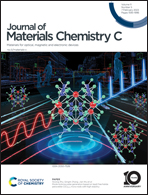Neomangiferin defect-engineering ZIF-8 for visually differentiating aprotic/protic solvents and real-time sensing trace water†
Abstract
The fabrication of unique and robust luminescent metal–organic frameworks (LMOFs) with new mechanisms and superior stability is urgently needed for multidimensional sensing applications; however, this remains a huge challenge. Herein, defective neomangiferin–ZIF-8, a novel LMOF with a unique ligand–ligand charge transfer mechanism, was fabricated by a facile de novo strategy. The obtained neomangiferin–ZIF-8 is highly stable with a reversible solvatochromic behavior and hydrogen-bonding-induced quenching effect. Thus, neomangiferin–ZIF-8 has been developed for the ultrafast (<1 s) visual differentiation of aprotic/protic solvents, and the rapid (8 s) and sensitive detection of trace water in organic solvents with high sensitivity (limit of detection 0.01–0.30%). Besides, the on-site real-time sensing of relative humidity in air with satisfying selectivity and reversibility was realized based on solid-state fluorescence. The excellent fluorescence properties of neomangiferin–ZIF-8 have demonstrated great potential in real environmental applications, and the proposed defect-engineering strategy offers guidance for the construction of novel LMOFs sensors.



 Please wait while we load your content...
Please wait while we load your content...